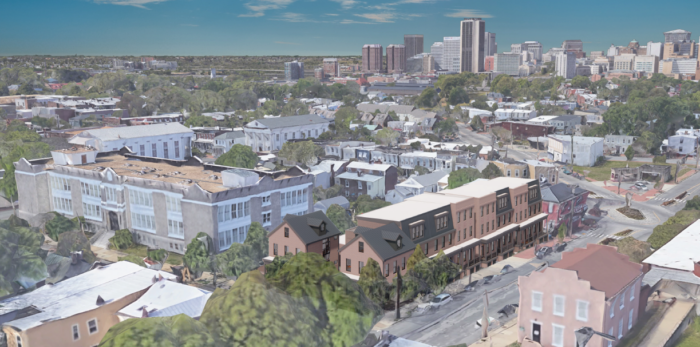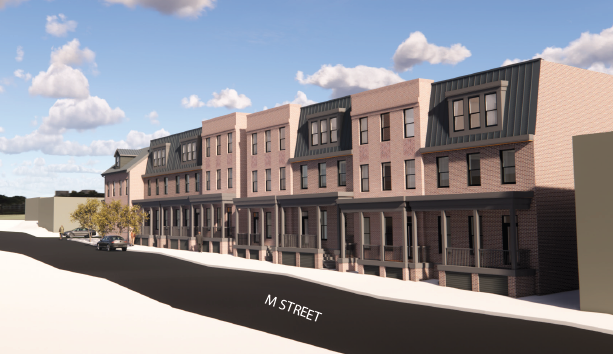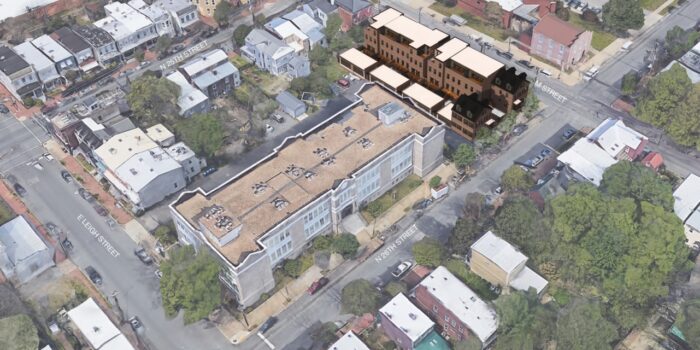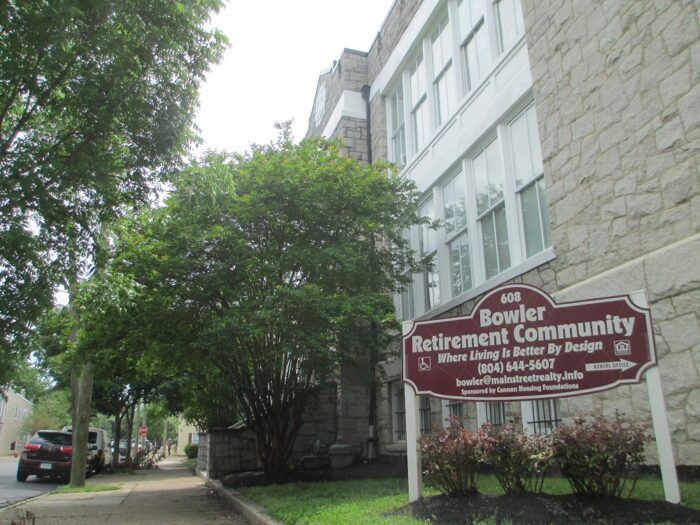
An aerial rendering shows the nine townhomes planned along M and 26th streets beside the former Bowler School that’s now senior apartments. (Images courtesy Daniil Kleyman)
A renovation in the works for a former school-turned-apartments building in the Church Hill area could make room for new homes behind The Roosevelt restaurant.
The owner of the Bowler Retirement Community, an income-based senior housing complex in the converted Bowler School at 26th and Leigh streets, is planning to sell part of the property to developer Daniil Kleyman, whose Evolve Development would add the nine townhomes as an infill project.
Seven of the homes would front M Street on the property’s north side, while the two remaining homes would front 26th and would be sold as lower-income units. The M Street units would be market-rate.
Kleyman, whose developments in the area include the nearby mixed-use building that’s filling out the triangular-shaped lot at Jefferson Avenue and M Street, said he was approached for the Bowler project by Louis Salomonsky, who redeveloped the former city school in the mid-1990s and manages the property’s ownership entity, Bowler Housing LP.
“I’ve known Louis for a while and I do a lot of development in Church Hill,” Kleyman said in an email of how the collaboration came about.
“These townhomes are a perfect complement to what we’re doing across the street,” Kleyman added, referring to the mixed-use building across 25th Street from The Roosevelt. “First, we add rentals and multiple street-facing businesses, then we add owner occupants. That’s how healthy neighborhoods get developed – you need all three.”
The townhomes also are integral to the apartments renovation, said Brian White, who runs Main Street Realty, the leasing and property management arm of Salomonsky’s and father David White’s Historic Housing development firm. He said equity from the sale of the land to Kleyman would help in funding the renovation, which is planned to also involve low-income housing tax credits.
“Selling some of that land to Daniil is the way we’re going to make it work, essentially,” Brian White said. “We’re going to use some low-income housing tax credits to get us there, but we don’t want to be in a position where we have to charge maximum tax credit rents. That’s just not the population that we serve out there.
“The only way that we can afford to redo the building is to get some equity into the deal in some way,” White said, adding that borrowed equity would be used in addition to proceeds from the sale and the credits to help finance the project and keep the apartment rents low.
Bowler’s 62 primarily one-bedroom apartments are fully occupied and currently rent from $725 to $840 a month. White said the land sale to Kleyman would help them keep rents in that range.
The renovation would include upgrades to unit interiors, with new flooring, countertops, cabinetry and appliances, as well as amenities for residents including an outdoor kitchen and games such as bocce ball or shuffleboard.
White said a cost estimate for the project has not been finalized, and the agreed-upon sale price for the land for the townhomes was not disclosed. The land makes up one-third of the larger 1.2-acre property, which the city has assessed at $2.09 million. The larger property last sold in 1995 for $300,000, property records show.
Kleyman’s three-level townhomes would line M Street and wrap around the corner at 26th, replacing a courtyard and part of Bowler’s existing parking lot. A new alley off 26th would run between the homes and the apartment building, providing access to two-car garages for the market-rate units and to the remaining parking lot, which would be reconfigured and reduced.
A site plan shows 17 off-street parking spaces beside the Bowler building, along with the gazebo and other amenities filling the site.
The new layout with the alley would return the townhomes portion of the property to the rowhouse-style development pattern that preceded the school’s construction in 1914, according to a special-use permit application filed for the project. The application notes that historical maps show that the northern part of the property was occupied by at least nine residential structures.

The three-story townhomes would include seven market-rate units fronting M Street. Two “workforce housing” units would front 26th Street around the corner.
The seven market-rate homes would range upwards from 3,100 square feet in size and include four bedrooms and 4½ bathrooms, which Kleyman described as rare for new construction in the area. The two lower-income homes would be 1,800-square-feet with three bedrooms and 2½ baths.
Kleyman said he hasn’t set prices for the homes and does not have a construction budget finalized. He worked with Architecture Design Office’s Todd Dykshorn on the homes’ design.
Pending approval of the permit, Kleyman said he hopes to break ground on the townhomes in late summer or early fall. The townhomes have gone through the city’s Commission of Architectural Review and are also subject to design requirements of the city’s Church Hill North Old and Historic District.
Where Kleyman and Dykshorn took that part of the project through CAR, the special-use permit that’s required for the overall project is being applied for by Bowler Housing LP. Local Roth Jackson attorney Mark Kronenthal is representing the property owner in its application, which is scheduled to go before the Planning Commission on June 6.
White said the apartments are due for the renovation, which he said would modernize the units and keep Bowler an attractive housing option for seniors.
“We know we need to renovate that building and those units. We did it 25 years ago, and other than maintaining it, it’s still the same building that it was 25 years ago,” White said. “We want to make it something better and something that is going to be positioned to be a nice place to live for a long time.”
Meanwhile, work continues on the nearby mixed-use building that Kleyman is developing with Matt Jarreau. Kleyman said the building, at 2416 Jefferson Ave., should be finished this fall with business tenants open by year-end.
He said the building’s apartments will be finished this summer and buildouts are beginning on the commercial spaces. Kleyman had previously targeted completion for last September, but he said supply chain issues and other delays dragged the project out.

An aerial rendering shows the nine townhomes planned along M and 26th streets beside the former Bowler School that’s now senior apartments. (Images courtesy Daniil Kleyman)
A renovation in the works for a former school-turned-apartments building in the Church Hill area could make room for new homes behind The Roosevelt restaurant.
The owner of the Bowler Retirement Community, an income-based senior housing complex in the converted Bowler School at 26th and Leigh streets, is planning to sell part of the property to developer Daniil Kleyman, whose Evolve Development would add the nine townhomes as an infill project.
Seven of the homes would front M Street on the property’s north side, while the two remaining homes would front 26th and would be sold as lower-income units. The M Street units would be market-rate.
Kleyman, whose developments in the area include the nearby mixed-use building that’s filling out the triangular-shaped lot at Jefferson Avenue and M Street, said he was approached for the Bowler project by Louis Salomonsky, who redeveloped the former city school in the mid-1990s and manages the property’s ownership entity, Bowler Housing LP.
“I’ve known Louis for a while and I do a lot of development in Church Hill,” Kleyman said in an email of how the collaboration came about.
“These townhomes are a perfect complement to what we’re doing across the street,” Kleyman added, referring to the mixed-use building across 25th Street from The Roosevelt. “First, we add rentals and multiple street-facing businesses, then we add owner occupants. That’s how healthy neighborhoods get developed – you need all three.”
The townhomes also are integral to the apartments renovation, said Brian White, who runs Main Street Realty, the leasing and property management arm of Salomonsky’s and father David White’s Historic Housing development firm. He said equity from the sale of the land to Kleyman would help in funding the renovation, which is planned to also involve low-income housing tax credits.
“Selling some of that land to Daniil is the way we’re going to make it work, essentially,” Brian White said. “We’re going to use some low-income housing tax credits to get us there, but we don’t want to be in a position where we have to charge maximum tax credit rents. That’s just not the population that we serve out there.
“The only way that we can afford to redo the building is to get some equity into the deal in some way,” White said, adding that borrowed equity would be used in addition to proceeds from the sale and the credits to help finance the project and keep the apartment rents low.
Bowler’s 62 primarily one-bedroom apartments are fully occupied and currently rent from $725 to $840 a month. White said the land sale to Kleyman would help them keep rents in that range.
The renovation would include upgrades to unit interiors, with new flooring, countertops, cabinetry and appliances, as well as amenities for residents including an outdoor kitchen and games such as bocce ball or shuffleboard.
White said a cost estimate for the project has not been finalized, and the agreed-upon sale price for the land for the townhomes was not disclosed. The land makes up one-third of the larger 1.2-acre property, which the city has assessed at $2.09 million. The larger property last sold in 1995 for $300,000, property records show.
Kleyman’s three-level townhomes would line M Street and wrap around the corner at 26th, replacing a courtyard and part of Bowler’s existing parking lot. A new alley off 26th would run between the homes and the apartment building, providing access to two-car garages for the market-rate units and to the remaining parking lot, which would be reconfigured and reduced.
A site plan shows 17 off-street parking spaces beside the Bowler building, along with the gazebo and other amenities filling the site.
The new layout with the alley would return the townhomes portion of the property to the rowhouse-style development pattern that preceded the school’s construction in 1914, according to a special-use permit application filed for the project. The application notes that historical maps show that the northern part of the property was occupied by at least nine residential structures.

The three-story townhomes would include seven market-rate units fronting M Street. Two “workforce housing” units would front 26th Street around the corner.
The seven market-rate homes would range upwards from 3,100 square feet in size and include four bedrooms and 4½ bathrooms, which Kleyman described as rare for new construction in the area. The two lower-income homes would be 1,800-square-feet with three bedrooms and 2½ baths.
Kleyman said he hasn’t set prices for the homes and does not have a construction budget finalized. He worked with Architecture Design Office’s Todd Dykshorn on the homes’ design.
Pending approval of the permit, Kleyman said he hopes to break ground on the townhomes in late summer or early fall. The townhomes have gone through the city’s Commission of Architectural Review and are also subject to design requirements of the city’s Church Hill North Old and Historic District.
Where Kleyman and Dykshorn took that part of the project through CAR, the special-use permit that’s required for the overall project is being applied for by Bowler Housing LP. Local Roth Jackson attorney Mark Kronenthal is representing the property owner in its application, which is scheduled to go before the Planning Commission on June 6.
White said the apartments are due for the renovation, which he said would modernize the units and keep Bowler an attractive housing option for seniors.
“We know we need to renovate that building and those units. We did it 25 years ago, and other than maintaining it, it’s still the same building that it was 25 years ago,” White said. “We want to make it something better and something that is going to be positioned to be a nice place to live for a long time.”
Meanwhile, work continues on the nearby mixed-use building that Kleyman is developing with Matt Jarreau. Kleyman said the building, at 2416 Jefferson Ave., should be finished this fall with business tenants open by year-end.
He said the building’s apartments will be finished this summer and buildouts are beginning on the commercial spaces. Kleyman had previously targeted completion for last September, but he said supply chain issues and other delays dragged the project out.







“We don’t want to be in a position where we have to charge maximum tax credit rents. That’s just not the population that we serve out there.”
I love this. Affordable senior housing is so hard to find. Thank you!!!